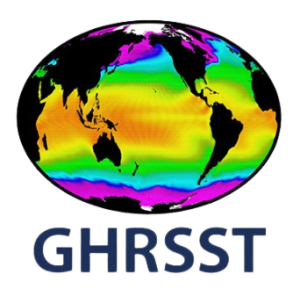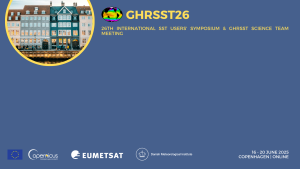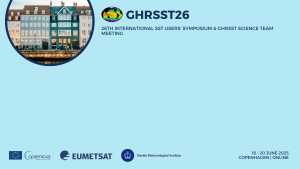About the 26th International SST Users’ Symposium and GHRSST Science Team Meeting (GHRSST26)
The 26th International SST Users’ Symposium and GHRSST Science Team Meeting (GHRSST26) will take place in Copenhagen, Denmark from June 16th to 20th, 2025 as a virtual and in-person meeting hosted by the Danish Meteorological Institute.
Dates: 16 – 20 June 2025
Target Audience: SST users, SST data producers, SST scientists, early career scientists, students interested in SST
Location: Copenhagen, Denmark/Online
Host: The Danish Meteorological Institute
GHRSST26 will be a hybrid event.
- Deadline for in-person registration was 15 April 2025
- Deadline for online registration is 1 June 2025
You can also sign-up for attending the GHRSST Team Building Activity which will take place on Wednesday, 18 June 2025. The activity will include a guided canal boat tour and a team dinner. You can register for the GHRSST Team Building Activity in the registration form below.
Deliveries of presentations, posters, and other related materials to be presented at GHRSST26 will be administered through the GHRSST 26 Moodle.
You must enroll into the GHRSST26 Moodle in order to submit your materials.
HOW-TO: Submit your Materials via GHRSST26 MoodleSTEP 1: Create an Account/Login to EUMETSAT Moodle. STEP 2: Enrol in the 26th International SST Users’ Symposium and GHRSST Science Team Meeting
STEP 3: Add your submissions
|
Resources for GHRSST26
Find the GHRSST26 Agenda here.
Please note that there may be adjusments to the agenda. You can find the most up to date program in the link above.
Read the GHRSST26 Book of Abstracts here.
Guidelines for presenters and participants at GHRSST26 both in-person and online will be made available here.
Templates for presentations (not required, use if needed): GHRSST26_PowerPoint_template
Logos
Click the images below and download for use in your materials.
Teams Backgrounds for Online Presenters
Click the images and save your desired background for use in Teams. Find out how to change your background in Teams here.
Science Sessions
Advances and Challenges of Surface Temperture in the Polar Regions
Despite their importance in the climate system, the Polar regions are heavily under-sampled both in terms of satellite- and in-situ surface temperature observations, which limits the possibilities for algorithm training and/or validation purposes. Observing, retrieving and analysing surface temperatures is very challenging in these regions due to the extreme environment, the mix of open water and sea ice (and the temporally varying sea ice cover), and the persistent cloud cover in the Arctic. This leads to large uncertainties and differences among the existing SST analyses in the Polar regions. Recent efforts have been made to get Sea Ice Surface Temperature (IST) homogenised with SST as a uniform variable to define and sample the boundaries between open ocean/ closed sea-ice, and there is a growing need to get these connected with the global L4 SST counterparts (and the auxiliary sea ice concentration products).
This session is dedicated to the challenging Polar regions for SST/IST retrieval, analysis and applications. The goal of this session is to provide an overview of the satellite and in-situ data available for the Polar regions and present new methods/analyses with the aim to improve the understanding, characterising and monitoring the Polar regions.
The session will focus on:
- Advances in SST/IST retrievals, in situ observations and products for the Polar regions
- Applications of high latitude SST/IST observations in assessments of climate change and variability
- Comparison and validation of SST/IST products in the Polar regions
- Advances in the representation of the marginal ice zone SST and combined SST/IST estimates
- Consistency between SST, IST and sea ice products
Keywords: Polar regions, Arctic amplification, sea ice, x-ECVs, boundaries, consistency, in situ observations
Global Sea (and Sea-Ice) Surface Temperature: Climate Data records, Trends, Indicators, and Definitions
Global sea surface temperature (SST) has been on a record high level in recent years, and climate data records are crucial tools for monitoring and understanding the dynamics of the Earth’s climate system and its ongoing changes. Continuous monitoring of SST provides a solid observational foundation for studying climate change and variability, allowing us to place current events within the context of historical patterns. To enhance user-uptake of SST (and other ocean) information, ocean/climate indicators are usually used to translate the data into practical metrics and guidance for policy-makers and the public. One such indicator is the global SST. Traditionally, global SST trends have been calculated for the extra-polar oceans or by using the under-ice SST provided in global L4 SST records. Recently, gap-free sea ice surface temperature (IST) climate data records have become available bringing a new possibility of calculating surface temperature trends in high latitudes.
This session will focus on the latest developments, trends, anomalies and extreme events observed in the global SST records. Special attention will the given to the typical use and definitions of global SST and Arctic SST, which have significant implications for understanding and monitoring climate change, in particular in high latitudes.
The session will focus on:
- Global SST/IST Climate Data Records (CDRs)
- Global SST definitions and indicators
- Recent trends in global SST and IST
- Challenges, consistency and uncertainties in global SST CDRs
Keywords: Global SST (and IST), climate data records, climate monitoring, climate/ocean indicators, trends, anomalies
Climate Change, Variability, and Applications of Sea and Sea-Ice Surface Temperature
Global and regional climate SST reanalyses and climate data records are essential for monitoring and characterisation of the climate system and its change. Sustained monitoring provides an observational basis for our understanding of climate change and variability and enables us to place current events into the context of the past. It draws upon information from in situ and satellite observations as well as dynamical reanalyses and climate models.
This session aims to highlight the recent advancements in SST climate data records and reanalyses with a particular focus on the observed trends, variabilities and the corresponding uncertainties. This session also welcomes contributions on the use of SST products in climate models for assimilation as well as model evaluations. Comparison and validation of climate simulations using different SST datasets are welcome, to provide information to producers that enable them to improve their products for specific applications. Finally, this session welcomes contributions on derived climate indicators (e.g. marine heatwaves) and new x-ECV products.
The session will focus on:
- Advances in observational climate and reanalysis SST products
- Applications of SST observations and reanalyses in global and regional assessments of climate change and variability
- Climate indicators and x-ECVs
- Applications of SST observations for assimilation, evaluation, and inter-comparisons of climate models and dynamical reanalyses
- Comparison and validation of climate simulations using different SST datasets
Keywords: Climate monitoring, climate data records and reanalyses, climate change and variability, trends, climate-indicators, dynamical reanalyses, climate model simulations
Atmospheric and Ocean Modelling and Reanalyses of SST
Numerical Weather Prediction (NWP) and Ocean modelling systems are essential for predicting the state of the atmosphere and ocean while coupled ocean-ice-atmosphere models have been largely used for many years already demonstrating a significant improvement in the forecast quality with respect to uncoupled systems. The Near-Real-Time (NRT) operational production and availability of SST data is essential for the support of NWP and ocean modelling systems. This session aims at highlighting the applicability of satellite-based SSTs for operational NWP and ocean modelling, coupled or uncoupled and including data assimilation, as well as reanalysis systems and climate models. Contributions on the use of SST products in climate models for assimilation as well as model evaluations, i.e. comparison and validation of climate simulations using different SST datasets are welcome, in order to provide information to producers to enable them to improve their products for specific applications.
Presentations on a wide range of topics, from NRT production and applications of SST data, observation operators for SST, direct assimilation of L1 satellite data, status of the operational systems and applications, climate modelling are welcomed.
The session will focus on:
- Applications of NRT SST products for NWP and Ocean Modelling
- Applications of direct data assimilation, observation operators
- Advances and challenges in coupled data assimilation systems for operational applications, reanalyses, and climate models
Keywords: NWP, Ocean modelling, Reanalyses, data assimilation, observation operators, climate modelling
From Observations to Products – Advances in SST Calibration, Validation, and Product Assessments
This session aims to highlight recent advancements in sea-surface temperature (SST), with a particular focus on the calibration and validation of satellite-derived SST products and the assessment of their quality and applicability, and a focus on in-situ/FRM datasets and inter-comparisons.
The session will focus on:
- Calibration and inter-calibration of satellite instruments.
- Validation of satellite-derived SST products.
- Comparisons between satellite data products and in situ measurements.
- Inter-comparisons of satellite data products from various platforms and sensors.
- Quality control and quality assurance of satellite data products.
- Evaluation of uncertainties and error sources in SST products.
Keywords: Calibration, intercalibration, validation, product assessment, inter-comparison, quality control, quality assurance, uncertainties, evaluation, error sources
Advances in Computing and Products
This session is dedicated to new and evolving approaches of computing techniques for GHRSST data product formulation, validation and scientific investigation. Results using methodology and workflows applying Artificial Intelligence and Machine Learning for SST products and analysis are encouraged. This session will also emphasise usage of cloud computing and storage, optimization of formats and processing software for the cloud, and parallel computation approaches.
The session will focus on:
- Challenges and advances in various computing techniques
- Artificial Intelligence and machine learning applications
- Challenges and advances cloud computing and storage technologies
Keywords: Computing, parallel computing, cloud computing, cloud storage, data formats, SST products and validation, Artificial Intelligence, Machine Learning
Air-Sea Interactions and Diurnal Variability
The coupling of the ocean and atmosphere is a fundamental characteristic of the Earth’s climate system and, on shorter time scales, a major influence on global weather patterns. There are five primary components of air-sea interactions: the radiative fluxes including (i) the shortwave energy from the sun and (ii) the longwave emission from the atmosphere, sun and ocean surface; the turbulent heat fluxes occurring through (iii) surface evaporation (latent heat) and (iv) heat loss by the ocean due to its overall higher temperature compared to the overlying atmosphere (sensible heat flux) and finally (v) the ocean’s water uptake through rainfall, which also introduces a heat flux as the raindrops are generally cooler than the ocean surface. The turbulent fluxes and the infrared emission from the sea surface are directly related to the sea surface temperature (SST). Furthermore, the diurnal variability of SST, driven by the coincident occurrence of moderately low winds and solar heating, is currently not properly understood and resolved in models and L4 SST products. This results in erroneous estimation of air-sea interactions, which can lead to demised oceanic and atmospheric model accuracies. In addition, diurnal SST variability complicates merging of SSTs from different satellite sensors thus having a direct impact on efforts to create climate data records. Finally, a misrepresentation of the diurnal variability of the upper ocean temperature may result in large errors when modelling harmful algal blooms.
Air-sea interactions and diurnal variability can be even more pronounced in coastal regions and enclosed ocean basins (e.g. the Baltic Sea) due to their proximity to land, turbidity, tidal motion/mixing, upwelling and/or high gradients as well as increased commercial and recreational activities. Furthermore, coastal regions are lacking satellite and in situ observations, which limits the possibilities for accurate studies of air-sea interactions and diurnal variability as well as algorithm training and for validation purposes.
This session is dedicated to air-sea interaction and diurnal variability on a global scale, as well as with a focus on the challenging coastal regions and enclosed basins. The goal is to provide an overview of applications, needs and challenges for SST to address the needs of studies on air-sea interactions and diurnal variability. Direct impact studies on applications related to coastal areas, e.g. offshore wind energy, algal blooms, fisheries and aquacultures are also welcome.
The session will focus on:
- Air-sea interaction estimates globally and in local scales, coastal areas, enclosed basins
- Applications of SST observations for air-sea interaction estimates
- Assessment of diurnal variability through SST observations and modelling
- Comparison and validation of SST products in coastal regions
Keywords: Air-sea interactions, diurnal variability, coastal areas, enclosed basins, applications, in situ observations
GHRSST26 Contact
For general questions, please contact the following persons:
- Erika Hayashi (GPO) ERH@dmi.dk










